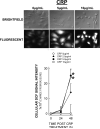Increased myocardial prevalence of C-reactive protein in human coronary heart disease: direct effects on microvessel density and endothelial cell survival
- PMID: 22285194
- PMCID: PMC3899797
- DOI: 10.1016/j.carpath.2011.12.003
Increased myocardial prevalence of C-reactive protein in human coronary heart disease: direct effects on microvessel density and endothelial cell survival
Abstract
Background: Elevated plasma C-reactive protein (CRP) is a biomarker of cardiovascular diseases (CVDs), but its potential roles as a participant of the disease process are not well defined. Although early endothelial cell injury and dysfunction are recognized events in CVD, the initiating events are not well established. Here we investigated the local myocardial CRP levels and cardiac microvessel densities in control and CVD tissue samples. Using in vitro methodologies, we investigated the direct effects of CRP on human endothelial cells.
Methods: Cardiac specimens were collected at autopsy within 4 h of death and were classified as normal controls or documented evidence of CVD. The regional prevalence of CRP and the cardiac microvessels (<40 μm) were investigated using immunohistochemistry. For in vitro experiments, human umbilical vein endothelial cells were incubated with CRP. Intracellular oxidant levels were assessed using 2',7'-dichlorofluorescein diacetate fluorescence microscopy, and cell survival was concurrently determined. Effects of chemical antioxidants on endothelial cell survival were also tested.
Results: Myocardial CRP levels were elevated in CVD specimens. This was associated with reduced cardiac microvessels, and this rarefaction was inversely correlated to adjacent myocardial CRP prevalence. CRP caused concentration-dependent increases in oxidant production and cell apoptosis.
Conclusions: These findings provide evidence supporting myocardial CRP as a locally produced inflammatory marker and as a potential participant in endothelial toxicity and microvascular rarefaction.
Copyright © 2012 Elsevier Inc. All rights reserved.
Figures






Similar articles
-
Myocardium and microvessel endothelium apoptosis at day 7 following reperfused acute myocardial infarction.Microvasc Res. 2010 Jan;79(1):70-9. doi: 10.1016/j.mvr.2009.11.003. Epub 2009 Nov 11. Microvasc Res. 2010. PMID: 19913038
-
C-reactive protein can influence the proliferation, apoptosis, and monocyte chemotactic protein-1 production of human umbilical vein endothelial cells.DNA Cell Biol. 2011 Mar;30(3):157-62. doi: 10.1089/dna.2010.1093. Epub 2010 Oct 27. DNA Cell Biol. 2011. PMID: 20979529
-
Coronary microvascular rarefaction and myocardial fibrosis in heart failure with preserved ejection fraction.Circulation. 2015 Feb 10;131(6):550-9. doi: 10.1161/CIRCULATIONAHA.114.009625. Epub 2014 Dec 31. Circulation. 2015. PMID: 25552356 Free PMC article.
-
Possible mechanisms of C-reactive protein mediated acute myocardial infarction.Eur J Pharmacol. 2015 Aug 5;760:72-80. doi: 10.1016/j.ejphar.2015.04.010. Epub 2015 Apr 18. Eur J Pharmacol. 2015. PMID: 25895642 Review.
-
Myocardial viability and microvascular obstruction: role of cardiac magnetic resonance imaging.Cardiol Rev. 2014 Sep-Oct;22(5):246-52. doi: 10.1097/CRD.0000000000000024. Cardiol Rev. 2014. PMID: 24621860 Review.
Cited by
-
Glycemic variability predicts inflammation in adolescents with type 1 diabetes.J Pediatr Endocrinol Metab. 2016 Oct 1;29(10):1129-1133. doi: 10.1515/jpem-2016-0139. J Pediatr Endocrinol Metab. 2016. PMID: 27658133 Free PMC article.
-
The secretome as a biomarker and functional agent in heart failure.J Cardiovasc Aging. 2023 Jul;3(3):27. doi: 10.20517/jca.2023.15. Epub 2023 Jun 9. J Cardiovasc Aging. 2023. PMID: 37484982 Free PMC article.
-
Risk Factors for Ankle Brachial Index and Carotid Artery Stenosis in Patients with Type 2 Diabetes.Metabolites. 2024 Jan 17;14(1):59. doi: 10.3390/metabo14010059. Metabolites. 2024. PMID: 38248862 Free PMC article.
-
Does Pre-Treatment with High Dose Atorvastatin Prevent Microvascular Dysfunction after Percutaneous Coronary Intervention in Patients with Acute Coronary Syndrome?Korean Circ J. 2016 Jul;46(4):472-80. doi: 10.4070/kcj.2016.46.4.472. Epub 2016 Jul 21. Korean Circ J. 2016. PMID: 27482255 Free PMC article.
-
Color Doppler imaging of the retrobulbar circulation and plasmatic biomarkers of vascular risk in age-related macular degeneration: A pilot study.Indian J Ophthalmol. 2018 Jan;66(1):89-93. doi: 10.4103/ijo.IJO_488_17. Indian J Ophthalmol. 2018. PMID: 29283130 Free PMC article.
References
-
- Black S, Kushner I, Samols D. C-reactive Protein. J Biol Chem. 2004 Nov 19;279(47):48487–90. - PubMed
-
- Dong Q, Wright JR. Expression of C-reactive protein by alveolar macrophages. J Immunol. 1996 Jun 15;156(12):4815–20. - PubMed
-
- Ouchi N, Kihara S, Funahashi T, Nakamura T, Nishida M, Kumada M, et al. Reciprocal association of C-reactive protein with adiponectin in blood stream and adipose tissue. Circulation. 2003 Feb 11;107(5):671–4. - PubMed
-
- Ridker PM, Cook N. Clinical usefulness of very high and very low levels of C-reactive protein across the full range of Framingham Risk Scores. Circulation. 2004 Apr 27;109(16):1955–9. - PubMed
Publication types
MeSH terms
Substances
Grants and funding
LinkOut - more resources
Full Text Sources
Research Materials
Miscellaneous

